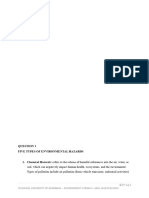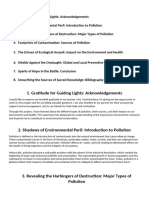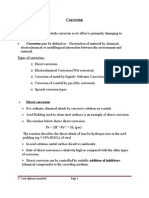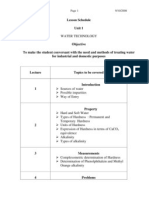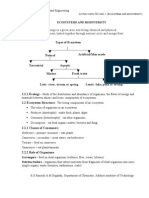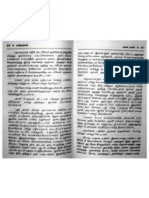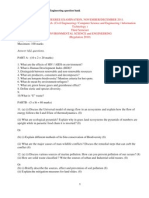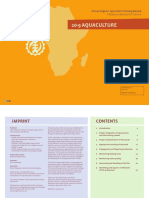Lecture Notes Unit 2
Lecture Notes Unit 2
Uploaded by
Shanmugam RameshCopyright:
Available Formats
Lecture Notes Unit 2
Lecture Notes Unit 2
Uploaded by
Shanmugam RameshCopyright
Available Formats
Share this document
Did you find this document useful?
Is this content inappropriate?
Copyright:
Available Formats
Lecture Notes Unit 2
Lecture Notes Unit 2
Uploaded by
Shanmugam RameshCopyright:
Available Formats
Environmental Science and Engineering Lecture notes for unit 3 (Environmental Pollution)
CHAPTER 3
3.1 Introduction
ENVIRONMENTAL POLLUTION
Environmental pollution can be defined as the unfavorable alteration of our surroundings
3.1.1 Types of pollutants
1. Bio degradable pollutants - decompose rapidly by natural processes. 2. Non- degradable pollutants - do not decompose or slowly decompose in the environment.
3.1.2 Classification of Pollution
Air pollution Water pollution Soil pollution Marine pollution Noise pollution Thermal pollution and Nuclear hazards
3.2 AIR POLLUTION
The presence of one or more contaminants like dust, smoke, mist and odor in the atmosphere which are injurious to human beings, plants and animals. 3.2.1 Sources of air pollution Natural pollution - volcanic eruptions, forest fires, biological decay. Man made activities Thermal power plants, agricultural activities.
3.2.2 Classification Primary pollutant these are those emitted directly in the atmosphere in harmful form like CO, NO. Secondary pollutant these may react with one another or with the basic components of air to form new pollutants.
3.2.3 Control Measures 1. Source control Use only unleaded petrol Use petroleum products and other fuels that have low sulphur and ash content
K.S.Ramesh & M.Suganthi, Department of Chemistry, Adithya Insrtitute of Technology
Environmental Science and Engineering Lecture notes for unit 3 (Environmental Pollution) Plant trees along busy streets because they remove particulates and carbon monoxide and absorb noise. Industries and waste disposal sites should be situated outside the city centre. Use catalytic converters to help control the emissions of carbon monoxide and hydrocarbons. 2. Control measures in Industrial centers Emission rates should be restricted to permissible levels Incorporation of air pollution control equipments in the design of the plant lay out.
3.3 WATER POLLUTION
o It may be defined as the alteration in physical, chemical and biological characteristics of water which may cause harmful effects on human and aquatic life. 3.3.1 Types, effects and sources of water pollution 1. Infectious agents: Bacteria, viruses, protozoa and parasitic worms. Sources: Human and animal wastes. Effects: Variety of diseases. 2. Oxygen demanding wastes: Animal manure and plant debris that can be decomposed by aerobic bacteria. Sources: Sewage, paper mills, and food processing facilities. Effects: Wastes can degrade quality by depleting water of dissolved oxygen. 3. In organic Chemicals: Water soluble inorganic chemicals. Compounds of toxic metals such as lead, arsenic and selenium. Salts such as Nacl in ocean water. Effects: Genetic mutations, birth defects and certain cancers. 4. Thermal pollution (Heat) Example: Excessive heat. 5. Human source Water cooling of electric power plants and some types of industrial plants. Almost all of all water withdrawn in United States for cooling electric power plants. 3.3.2 Effects Lowers dissolved oxygen levels and makes aquatic organisms more vulnerable to disease and toxic chemicals When a power plant first opens or shuts down for repair, fish and other organisms adapted to a particular temperature range can be killed b the abrupt change in water temperature known as thermal shock. 3.3.3 Control measures of water pollution
K.S.Ramesh & M.Suganthi, Department of Chemistry, Adithya Insrtitute of Technology
Environmental Science and Engineering Lecture notes for unit 3 (Environmental Pollution) The administration of water pollution should be in the hands of state or central government. Industrial plants should be based on recycling operations, because it will not only stop the discharge of industrial wastes into natural water sources but by products can be extracted from the wastes. Plants, trees and forests control pollution and they acts as natural air conditioners. Highly qualified and experienced persons should be consulted from time to time for effective control of water pollution. Basic and applied research in pubic health engineering should be encouraged.
3.4 SOIL POLLUTION
It may be defined as the contamination of soul by human and natural activities which may cause harmful effects on living beings. 3.4.1 Types 1. Industrial wastes Sources and effects: Pulp and paper mills, chemical industries, oil refineries, sugar factories. These pollutants affect and alter the chemical and biological properties of soil. As a result, hazardous chemicals can enter into human food chain from the soil; disturb the bio chemical process and finally lead to serious effects. 2. Urban wastes Sources and effects: Plastics, Glasses, metallic cans, fibers, papers, rubbers, street sweepings, and other discarded manufactured products. These are also dangerous. 3. Agricultural practices Sources and effects: Huge quantities of fertilizers, pesticides, herbicides, and weedicides are added to increase the crop yield. Apart from these farm wastes, manure, slurry, are reported to cause soil pollution. 4. Radioactive pollutants Sources and effects: These are resulting from explosions of nuclear dust and radio active wastes penetrate the soil and accumulate there by creating land pollution. 5. Biological agents Sources and effects: Soil gets large quantities of human, animal and birds excreta which constitute the major source of land pollution by biological agents. 3.4.2 Control measures of soil pollution The pressure on intensification of farm activities increases for two reasons Population growth Decrease of the available farm land due to urbanization Forestry and farm practices Proper dumping of unwanted materials
K.S.Ramesh & M.Suganthi, Department of Chemistry, Adithya Insrtitute of Technology
Environmental Science and Engineering Lecture notes for unit 3 (Environmental Pollution) Production of natural fertilizers Proper Hygienic condition Public awareness Recycling and Reuse of wastes Ban on Toxic chemicals.
3.5 MARINE POLLUTION
It may be defined as the discharge of waste substances into the sea resulting in harm to living resources hazards to human health, hindrance to fishery and impairment of quality for use of sea water. Source of marine pollution The coastal zones contain rich heritage, coral reefs, wetlands, and sea grass beds. 3.5.1 Effects of marine pollutants The presence of heavy metals and organic pollutants cause more damage in birds as thinning of eggshell and tissue damage of egg. Oil spilling causes abnormally low body temperature in birds resulting in hypothermia. Oil films are able to retard significantly the rate of oxygen uptake by water. 3.5.2 Control measures of marine pollution Plants for conserving marine biodiversity must be taken into account of human needs. People should be educated about marine ecosystems and the benefits offered by them. Local communities must be involved in protecting and managing their coastal resources. Social and economic incentives must be offered for conserving and sustainable use of marine resources. Governments must manage their own water while extending cooperation to the neighboring states.
3.6 NOISE POLLUTION
It may be defined as the unwanted, unpleasant or disagreeable sound that causes discomfort for all living beings 3.6.1 Types of noise Industrial noise Transport noise Neighborhood noise 3.6.2 Effects of Noise pollution This affects human health, comfort and efficiency. It causes muscles to contract leading to nervous breakdown, tension.
K.S.Ramesh & M.Suganthi, Department of Chemistry, Adithya Insrtitute of Technology
Environmental Science and Engineering Lecture notes for unit 3 (Environmental Pollution) It affects health efficiency and behavior. In addition to serious loss of hearing due to excessive noise, impulsive noise also causes psychological and pathological disorders. Brain is also adversely affected by loud and sudden noise as that of jet and aero plane noise. 3.6.3 Control and preventing measures Source control acoustic treatment to machine surface, design changes, limiting the operational timings. Transmission path intervention- the source inside a sound insulating enclosure, construction of a noise barrier or provision of sound absorbing materials. Oiling Proper oiling will reduce the noise from the machines.
3.7 THERMAL POLLUTION
It may be defined as the addition of excess of undesirable heat to water that makes it harmful to man, animal or aquatic life or otherwise causes significant departures from the normal activities of aquatic communities in water 3.7.1 Sources of thermal pollution Nuclear power plants Coal fired power plants Industrial effluents Domestic sewage Hydro electric power.
3.7.2 Effects of thermal pollution Reduction in dissolved oxygen Increase in Toxicity Interference with biological activities Interference with reproduction Direct mortality Food storage for fish.
3.7.3 Control measures of thermal pollution Cooling towers - This is used as a coolant wet cooling tower, dry cooling tower. Cooling ponds and spray ponds. Artificial lakes The heated effluents can be discharged into the lake at one end and the water for cooling purposes from the other end.
3.8 NUCLEAR HAZARDS
K.S.Ramesh & M.Suganthi, Department of Chemistry, Adithya Insrtitute of Technology
Environmental Science and Engineering Lecture notes for unit 3 (Environmental Pollution) The radiation hazard in the environment comes from ultraviolet, visible, cosmic rays and micro wave radiation which produces genetic mutation in man. 3.8.1 Sources of Nuclear Hazards Natural Sources This is in space which emits cosmic rays. Man made Sources (Anthropogenic sources) these are nuclear power plants, X-rays, nuclear accidents, nuclear bombs, diagnostic kits. 3.8.2 Effects of Nuclear Hazards Exposure of the brain and central nervous system ot high doses of radiation causes delirium, convulsions and death within hours or days. The use of eye is vulnerable to radiation. As its cell die, they become opaque forming cataracts that impair sight. Acute radiation sickness is marked by vomiting; bleeding of gums and in severe cases mouth ulcers. Nausea and vomiting often begin a few hours after the gastrointestinal tract is exposed. Infection of the intestinal wall can kill weeks afterwards. Unborn children are vulnerable to brain damage or mental retardation, especially if irradiation occurs during formation of the central nervous system in early pregnancy. 3.8.3 Control measures Nuclear devices should never be exploded in air. In nuclear reactors, closed cycle coolant system with gaseous coolant may be used to prevent extraneous activation products. Containments may also be employed to decrease the radio active emissions. Extreme care should be exercised in the disposal of industrial wastes contaminated with radio nuclides. Use of high chimneys and ventilations at the working place where radioactive contamination is high. It seems to be an effective way for dispersing pollutants.
3.9 SOLID WASTE MANAGEMENT
Management of solid waste is very important in order to minimize the adverse effects of solid wastes. 3.9.1 Types of solid wastes 1. Urban wastes Sources Domestic wastes Food waste, Cloth, Waste paper. Commercial wastes Packing material, cans, bottles, polythene. Construction Wastes Wood, concrete debris.
K.S.Ramesh & M.Suganthi, Department of Chemistry, Adithya Insrtitute of Technology
Environmental Science and Engineering Lecture notes for unit 3 (Environmental Pollution) Bio medical wastes Anatomical wastes, infectious wastes. 2. Industrial wastes Sources Nuclear power plants generates radioactive wastes Thermal power plants produces fly ash in large quantities 3. Chemical industries Produces large quantities of hazardous and toxic materials 3.9.2 Steps involved in solid waste management Reduce, Reuse and Recycle of materials raw materials re usage should be reduced, reuse of waste materials should be reduced and recycling of the discarded materials into new useful products should also be reduced. Discarding wastes Land fill: Solid wastes are placed in sanitary landfill system in alternate layers of 80 cm thick refuse, covered with selected earth fill of 20cm thickness Incineration: It is a hygienic way of disposing the solid waste. It is a thermal process and is very effective for detoxification of all combustible pathogens Composting: It is another popular method practiced in many cities in our country. In this method, bulk organic waste is converted into fertilizing manure by biological action. 3.9.3 Role of an individual in prevention of pollution Plant more trees Help more in pollution prevention than pollution control Use water, energy and other resources efficiently Purchase recyclable, recycled and environmentally safe products Reduce deforestation Remove NO from motor vehicular exhaust Use of eco friendly products. 3.9.4 Case studies Effluents treatment at MRL, Chennai The Bhopal gas tragedy Arsenic pollution in ground water Soft drink bottling unit Mercury wastes Palar river pollution The miniamatta epidemic (marine pollution) 3.10 DISASTER MANAGEMENT Hazard It is a perceived natural event which threatens both life and property.
K.S.Ramesh & M.Suganthi, Department of Chemistry, Adithya Insrtitute of Technology
Environmental Science and Engineering Lecture notes for unit 3 (Environmental Pollution) Disaster A disaster is the realization of this hazard It is defined as the geological process and it is an event concentrated in time and space in which a society or subdivision of a society undergoes severe danger and causes loss of its members and physical property. Types Natural disasters refers to those disasters that are generated by natural phenomena. Man made disasters refers to the disasters resulting from man made hazards. 3.11 FLOODS Whenever the magnitude of water flow exceeds the carrying capacity of the channel within its banks the excess of water overflows on the surroundings causes floods. 3.11.1 Causes of floods Heavy rain, rainfall during cyclone causes floods Sudden snow melt also raises the quantity of water in streams and causes flood Sudden and excess release of impounded water behind dams Clearing of forests for agriculture has also increased severity of floods.
3.11.2 Flood Management Encroachment of flood ways should be banned. Building walls prevent spilling out the flood water over flood plains. Diverting excess water through channels or canals to areas like lake, rivers where water is not sufficient. Optical and microwave data from IRS is also used for flood management. Flood forecasts and flood warning are also given by the central water commission. 3.12 CYCLONES It is a meteorological process, intense depressions forming over the open oceans and moving towards the land. Cyclone is measured by Saffir-Simpson scale.
K.S.Ramesh & M.Suganthi, Department of Chemistry, Adithya Insrtitute of Technology
Environmental Science and Engineering Lecture notes for unit 3 (Environmental Pollution)
Fig.3.1 Saffir Simpson scale 3.12.1 Effect The damage depends on the intensity of cyclone the damage to human life, crops, roads, transport, could be heavy. Cyclone occurrence slows down the developmental activities of the area. Table 3.1 Classification of cyclones based on their speed
K.S.Ramesh & M.Suganthi, Department of Chemistry, Adithya Insrtitute of Technology
Environmental Science and Engineering Lecture notes for unit 3 (Environmental Pollution) 3.12.2 Cyclone management Satellite images are used by meteorological departments for forecasting the weather conditions which reveal the strength and intensity of the storm. Radar system is used to detect the cyclone and is being used for cyclone warning. 3.12.3 Case studies Cyclone in Orissa 1999 Two cyclones in Orissa occurred on 18th and 29th October 1999.In the coastal area of Orissa, a powerful cyclone storm hit with a wind velocity of about 260 km/hr. Nearly 14-30 districts of Orissa were in severe damage. It has been reported that nearly 15 millions of people were affected and 90-95% of the crop yield was affected. About 11,500 local schools have been damaged. 3.13 LAND SLIDES The movement of earthy materials like coherent rock, mud, soil and debris from higher to lower region to gravitational pull is called land slides. 3.13.1 Causes Movement of heavy vehicles on the unstable sloppy regions. Earthquake, shocks, vibrations and cyclone. 3.13.2 Effects of landslides 1. Block roads and diverts the passage. 2. Soil erosion increases. 3. Causes damages to houses, crops and live stock. 3.14 EARTH QUAKES An earthquake is a sudden vibration caused on earth surface with the sudden release of tremendous energy stored in rocks under the earths crust. 3.14.1 Causes 1. Disequilibrium in any part of the earth crust 2. Underground nuclear testing 3. Decrease of underground water level. 3.14.2 Severity of an earthquake: Generally it is measured by its magnitude on Richter scale. Richter Scale Severity of earthquake Less than 4 Insignificant 4- 4.9 Minor 5- 5.9 Damaging 6- 6.9 Destructive 7- 7.9 Major More than 8 Great 3.14.3 Effect Damage the settlements and transport systems
K.S.Ramesh & M.Suganthi, Department of Chemistry, Adithya Insrtitute of Technology
Environmental Science and Engineering Lecture notes for unit 3 (Environmental Pollution) Collapses houses and their structures Deformation of ground surface Tsunami
3.14.4 Earthquake Management Constructing earthquake resistant building Wooden houses are preferred Seismic hazard map should give the information about the magnitude of intensity of anticipated earthquakes. 3.15 TSUNAMI A tsunami is a large wave that is generated in a water body when the seafloor is deformed by seismic activity. This activity displaces the overlying water in the ocean. 3.15.1 Causes of tsunami Seismic activities like earthquakes, landslides, volcanic eruptions, explosions, can generate tsunami. Deformation of the sea floor due to the movement of plates.
Fig.3.1 Formation of Tsunami 3.15.2 Concept of Tsunami A tsunami is not a single wave but a series of waves like the ordinary waves which we see on seas. 3.15.3 Effects on Tsunami
K.S.Ramesh & M.Suganthi, Department of Chemistry, Adithya Insrtitute of Technology
Environmental Science and Engineering Lecture notes for unit 3 (Environmental Pollution) Tsunami attacks mostly the coastlines, causing devastating property, damage and loss of life. Tsunami can kill lot of human beings, livestocks. Tsunami may also spread lot of water borne diseases.
3.15.4 Tsunami Management Earthquakes under the water are monitored by sensors on the floor of the sea. The sensors send the information of floating buoys on the surface, whenever they detect any changes in pressure of the sea. The information is then relayed to satellites, which passes it on to the earth stations. Finally the country make the people alert through the media to take all necessary precautions. 3.15.5 Case studies Tsunami- Japan 2011, India 2004.
K.S.Ramesh & M.Suganthi, Department of Chemistry, Adithya Insrtitute of Technology
You might also like
- Construction Tools and Their UsesDocument20 pagesConstruction Tools and Their UsesMarsheil Bawaan75% (8)
- Grade 6 T.L.EDocument4 pagesGrade 6 T.L.EAgyao Yam Faith100% (18)
- Unit-2 EVS PDFDocument12 pagesUnit-2 EVS PDFRegional Lab VPMNo ratings yet
- Veltech Dr. RR & Dr. SR University Department of Chemistry Environmental Studies Unit-Iii Environmental PollutionDocument10 pagesVeltech Dr. RR & Dr. SR University Department of Chemistry Environmental Studies Unit-Iii Environmental PollutionPOREDDY BHARATH KUMAR REDDY Mechanical EngineeringNo ratings yet
- ENVIRONMENTAL-POLLUTION_100855Document6 pagesENVIRONMENTAL-POLLUTION_100855Jeoferson Jose ValdezNo ratings yet
- Environmental Studies Unit-Iii Environmental PollutionDocument11 pagesEnvironmental Studies Unit-Iii Environmental Pollutiongeethika kothapalliNo ratings yet
- Environmental-Pollution +1 AssignmentDocument4 pagesEnvironmental-Pollution +1 Assignmentzain61086% (28)
- Introduction To Polluted Natural ResourcesDocument10 pagesIntroduction To Polluted Natural ResourcesoshanmitkariNo ratings yet
- PollutionDocument6 pagesPollutionMinu Madhu KumarNo ratings yet
- Environmental PollutionDocument19 pagesEnvironmental Pollutionchinedumpeters31No ratings yet
- PHILOSOPHY GROUP REPORT REVIEWER_1Document5 pagesPHILOSOPHY GROUP REPORT REVIEWER_1janinneleidoNo ratings yet
- Environmental AssignmentDocument16 pagesEnvironmental AssignmentfishNo ratings yet
- MPM 721 Chapter 1Document63 pagesMPM 721 Chapter 1NAZRAWI GETACHEWNo ratings yet
- Unit 2 POLLUTIONDocument13 pagesUnit 2 POLLUTIONrahilrai0007No ratings yet
- Air PollutionDocument9 pagesAir Pollutionvijayprajapati24646No ratings yet
- SEMIFINAL ENVIRONMENTAL (REPORT)Document3 pagesSEMIFINAL ENVIRONMENTAL (REPORT)BERNAS, FRANKLIN IRICANo ratings yet
- Environmental Biotechnology: by Y. Mohamed Musthak Ii M.SC., BioteechnologyDocument24 pagesEnvironmental Biotechnology: by Y. Mohamed Musthak Ii M.SC., Bioteechnologypradha1409No ratings yet
- Define Environment and Factor of Environmental PollutionDocument6 pagesDefine Environment and Factor of Environmental PollutionAdan Hooda100% (2)
- Sandesh 182Document25 pagesSandesh 182Sandesh salveNo ratings yet
- Environmental Problems WorldwideDocument7 pagesEnvironmental Problems Worldwide12anniverNo ratings yet
- A Review On Theoretical Air Pollutants Dispersion ModelsDocument7 pagesA Review On Theoretical Air Pollutants Dispersion ModelsMusaab MohamedNo ratings yet
- Group 3. FinalDocument9 pagesGroup 3. FinalMichaella Corine GonzalesNo ratings yet
- Impact of Humans On The EnvironmentDocument7 pagesImpact of Humans On The EnvironmentramsaykrisinaNo ratings yet
- Evs Unit 3 QB & AnswerDocument8 pagesEvs Unit 3 QB & AnswerManoj ManoNo ratings yet
- Unit 2 Environmental PollutionDocument11 pagesUnit 2 Environmental Pollutionhmmailbox36No ratings yet
- EEESDocument21 pagesEEESHardik kapoorNo ratings yet
- Wa0032Document14 pagesWa0032DschaushariNo ratings yet
- ENVIRONMENTDocument6 pagesENVIRONMENTjaredmbinjiNo ratings yet
- Sekolah Menengah Kebangsaan Gajah Berang: Title: Chapter 9: Endangered EcosystemsDocument15 pagesSekolah Menengah Kebangsaan Gajah Berang: Title: Chapter 9: Endangered EcosystemsChristine TanNo ratings yet
- Unit - 3 Environmental Pollution ObjectivesDocument10 pagesUnit - 3 Environmental Pollution ObjectivesKavitha SubramaniamNo ratings yet
- Narrative Report-Group4Document6 pagesNarrative Report-Group4Chel SeaNo ratings yet
- Unit 3Document15 pagesUnit 3kirankatila99No ratings yet
- Evs ProjectDocument14 pagesEvs ProjectPradeep SharmaNo ratings yet
- Air, Water, Soil PollutionDocument3 pagesAir, Water, Soil PollutionChrisNo ratings yet
- PollutionDocument13 pagesPollutionMrs HeptaNo ratings yet
- Module - 3 Environmental Pollution Envt Policies and Practices WNcVRhIzKxDocument55 pagesModule - 3 Environmental Pollution Envt Policies and Practices WNcVRhIzKxSUNG-JINN WOONo ratings yet
- Pollution, Meaning, Causes, Classifications Air, Water, Sound, LandDocument14 pagesPollution, Meaning, Causes, Classifications Air, Water, Sound, LandPranjal RaiNo ratings yet
- Environmental PollutionDocument10 pagesEnvironmental PollutionPragya AgrahariNo ratings yet
- POLLUTIONDocument20 pagesPOLLUTIONCharles EsicoNo ratings yet
- Study-Material 2 -10-15Document77 pagesStudy-Material 2 -10-15aakritisharma1cNo ratings yet
- Study-Material 2 -10-12Document51 pagesStudy-Material 2 -10-12aakritisharma1cNo ratings yet
- EnvironmentDocument9 pagesEnvironmentgeni dalbongNo ratings yet
- Department of Petrochemical Engineering: Summer Training Program (2019 - 2020)Document10 pagesDepartment of Petrochemical Engineering: Summer Training Program (2019 - 2020)soran najebNo ratings yet
- Chapter 3 PollutionDocument11 pagesChapter 3 PollutionSarmiento August M.No ratings yet
- Pollution A Looming Global CrisisDocument8 pagesPollution A Looming Global Crisisfurtti704No ratings yet
- Assignment Water PollutionDocument12 pagesAssignment Water PollutionM ImranNo ratings yet
- HazardsDocument6 pagesHazardsjaredmbinjiNo ratings yet
- 7086 Ganesh Suresh LoleDocument5 pages7086 Ganesh Suresh LoleetgrgrfdNo ratings yet
- EVS Unit-1 NotesDocument6 pagesEVS Unit-1 Notessikesag308No ratings yet
- Evs 2 MarkDocument74 pagesEvs 2 MarkArun Raja K KNo ratings yet
- Environmental Degradation 1.0Document9 pagesEnvironmental Degradation 1.0ranisailorspridecollegeNo ratings yet
- ENVIRONMENTAL SCIENCE AND ENGINERING Group 5Document5 pagesENVIRONMENTAL SCIENCE AND ENGINERING Group 5Remigie CowayNo ratings yet
- Environmental Pollution and Hazards: StructureDocument22 pagesEnvironmental Pollution and Hazards: StructureramanNo ratings yet
- Types of PollutionDocument8 pagesTypes of PollutionspiffyahadNo ratings yet
- PollutionDocument6 pagesPollutionsiyay86293No ratings yet
- PollutionDocument2 pagesPollutionPankaj mittalNo ratings yet
- Pollution and The Types A Brief ExplanationDocument8 pagesPollution and The Types A Brief Explanationdhanushg131No ratings yet
- Pollution Bio Class X NotesDocument5 pagesPollution Bio Class X NotesAdiNo ratings yet
- EST Micro ProjectDocument22 pagesEST Micro Projectmohammad.rashid2181No ratings yet
- Agro-Forestrium Hyperaccumulator Plant To Clean Toxic Plastic Waste & Micro Plastic Waste From NatureFrom EverandAgro-Forestrium Hyperaccumulator Plant To Clean Toxic Plastic Waste & Micro Plastic Waste From NatureNo ratings yet
- Unit VI One MarksDocument11 pagesUnit VI One MarksShanmugam RameshNo ratings yet
- Corrosion: Corrosion May Be Defined As - Destruction of Material by ChemicalDocument14 pagesCorrosion: Corrosion May Be Defined As - Destruction of Material by ChemicalRavi RaiNo ratings yet
- Nano ChemistryDocument20 pagesNano ChemistryShanmugam Ramesh100% (2)
- Water Gas - Shift ReactionDocument2 pagesWater Gas - Shift ReactionShanmugam RameshNo ratings yet
- WWW Thelecturernotes BlogspotDocument9 pagesWWW Thelecturernotes BlogspotShanmugam RameshNo ratings yet
- Lesson Schedule Unit 1: VSG & Ky 9/10/2008Document37 pagesLesson Schedule Unit 1: VSG & Ky 9/10/2008Shanmugam RameshNo ratings yet
- Phaase EquilibriaDocument1 pagePhaase EquilibriaShanmugam RameshNo ratings yet
- Instruments & SourceDocument1 pageInstruments & SourceShanmugam RameshNo ratings yet
- Lecture Notes Unit 1Document25 pagesLecture Notes Unit 1Shanmugam Ramesh100% (2)
- Engineering Chemistry - II: Re-Internal Assessment Test - IIDocument2 pagesEngineering Chemistry - II: Re-Internal Assessment Test - IIShanmugam RameshNo ratings yet
- NET InformationDocument3 pagesNET InformationShanmugam RameshNo ratings yet
- Lecture Notes Unit 1Document25 pagesLecture Notes Unit 1Shanmugam Ramesh100% (2)
- YAVANARANI-02 HQ 4Document50 pagesYAVANARANI-02 HQ 4Shanmugam RameshNo ratings yet
- Question BankDocument17 pagesQuestion BankShanmugam RameshNo ratings yet
- Completed Physics ManualDocument120 pagesCompleted Physics ManualShanmugam RameshNo ratings yet
- Ist Yr Ist Sem QSTN BankDocument66 pagesIst Yr Ist Sem QSTN BankachuthannayakiNo ratings yet
- Agric Extract.Document11 pagesAgric Extract.hola bolaNo ratings yet
- 2 Sem Botany - Question BankDocument62 pages2 Sem Botany - Question BankOjan Benard LeoNo ratings yet
- Soil Mechanics - Problems 1Document2 pagesSoil Mechanics - Problems 1MJ ArboledaNo ratings yet
- Request For Soil PropertiesDocument1 pageRequest For Soil PropertiesHanafiahHamzahNo ratings yet
- MR Chhabilal Timilsina - Sitapaila - SOil Test Report PDFDocument46 pagesMR Chhabilal Timilsina - Sitapaila - SOil Test Report PDFAnonymous GaaXAYYNo ratings yet
- Preliminary Landscape Plan: Submitted byDocument9 pagesPreliminary Landscape Plan: Submitted byRahul TomarNo ratings yet
- JPS 006 007 Jaya Impact SpinachDocument7 pagesJPS 006 007 Jaya Impact SpinachVipul SharmaNo ratings yet
- GST 06101-Module 4Document24 pagesGST 06101-Module 4Abuu MuzamiluNo ratings yet
- Effects of Gravel Content On Shear Resistance of Gravelly SoilsDocument13 pagesEffects of Gravel Content On Shear Resistance of Gravelly SoilsRuben Ñahue Rimache100% (1)
- We Are Intechopen, The World'S Leading Publisher of Open Access Books Built by Scientists, For ScientistsDocument20 pagesWe Are Intechopen, The World'S Leading Publisher of Open Access Books Built by Scientists, For ScientistsHadrien FaryalaNo ratings yet
- Bhil Tribal Mobilisation in AlirajpurDocument14 pagesBhil Tribal Mobilisation in Alirajpurrahul banerjeeNo ratings yet
- Earthsci Q1 Module7Document22 pagesEarthsci Q1 Module7Paris Azarcon TajanlangitNo ratings yet
- SST Class X NotesDocument24 pagesSST Class X NotesVidisha100% (1)
- Tree-Crop InteractionsDocument8 pagesTree-Crop Interactionsfatihah ibrahimNo ratings yet
- 3 Soil Engineering Parameters 2011 PDFDocument33 pages3 Soil Engineering Parameters 2011 PDFGuillermo MondeNo ratings yet
- African Organic Agriculture Training ManualDocument25 pagesAfrican Organic Agriculture Training Manualfshirani7619No ratings yet
- Vibroflotation VFDocument4 pagesVibroflotation VFimanacoNo ratings yet
- ConservationPlanter, DrillandAir-Type Seeder Selection GuidlineDocument10 pagesConservationPlanter, DrillandAir-Type Seeder Selection Guidlinejorge76No ratings yet
- 1126-Article Text-3460-1-10-20230309Document14 pages1126-Article Text-3460-1-10-20230309zerfuderesu13No ratings yet
- Pesticide Toxicity To Non-Target Organisms: Johnson Stanley Gnanadhas PreethaDocument531 pagesPesticide Toxicity To Non-Target Organisms: Johnson Stanley Gnanadhas PreethaAmod KumarNo ratings yet
- Assignment IisrDocument10 pagesAssignment Iisritsvs99No ratings yet
- Talawakelle Tea EstatesDocument16 pagesTalawakelle Tea EstatesDon SandamaliNo ratings yet
- Agroforestry - A Viable Option For Crop Diversification in Punjab in EnglishDocument28 pagesAgroforestry - A Viable Option For Crop Diversification in Punjab in EnglishSahil SinghNo ratings yet
- Terra Preta, Christoph SteinerDocument34 pagesTerra Preta, Christoph SteinerVasiliniuc Ionut100% (1)
- Luger 2018 Redesign MMF ModelDocument28 pagesLuger 2018 Redesign MMF Modelcatur rizky rahmanNo ratings yet
- Q1.A Student Was Asked To Estimate How Many Clover Plants There Are in The School FieldDocument23 pagesQ1.A Student Was Asked To Estimate How Many Clover Plants There Are in The School FieldGreshilea ArvinNo ratings yet














































